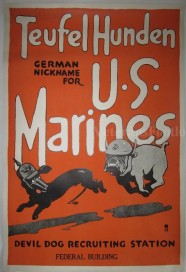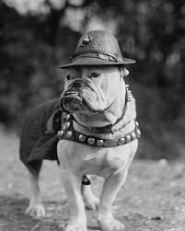![]() In 1917, Major General George Barnett, then serving as Commandant of the Marine Corps, established a committee to consider various locations for a new Marine Corps training base. The area selected was Quantico, initially titled Marine Barracks, Quantico. The initial complement consisted of four officers and 91 enlisted Marines. Quantico became the training ground for Marines being ordered to Europe with the American Expeditionary Forces. One of the early commanders at Quantico was Smedley D. Butler, the only Marine Officer to receive two awards of the Medal of Honor. After World War I, Quantico became the site for Marine Corps Schools.
In 1917, Major General George Barnett, then serving as Commandant of the Marine Corps, established a committee to consider various locations for a new Marine Corps training base. The area selected was Quantico, initially titled Marine Barracks, Quantico. The initial complement consisted of four officers and 91 enlisted Marines. Quantico became the training ground for Marines being ordered to Europe with the American Expeditionary Forces. One of the early commanders at Quantico was Smedley D. Butler, the only Marine Officer to receive two awards of the Medal of Honor. After World War I, Quantico became the site for Marine Corps Schools.
While at Quantico in 1922, then Brigadier General Smedley Butler presided over a ceremony where the first English Bulldog was enlisted as a mascot into the Marine Corps. Well, okay … mascots appear in all the services in the US Armed Forces, but why did the Marines settle on an English Bulldog? In order to answer this question, we must first return to the time of World War I, which was the first major test in battle for the United States Marine Corps.
The test occurred at a place called Belleau Wood. The Germans had advanced within fifty miles of Paris, France and Belleau Wood was part of an allied campaign designed to push back against the German Spring Offensive. The battle raged for three excruciating weeks before the Marines defeated their German enemies. After the battle, General Pershing said that he thought Belleau Wood may have been the most important American battle since the Civil War.
 Belleau Wood is where the fighting Esprit of the Marines and the tenacity of the English Bulldog became as one. What German prisoners told us was that the American Marines fought liked devil dogs —and so the Germans began calling the Marines Teufel Hunden. In Bavarian mythology, devil dogs were wild animals that lived in the mountains; it was a myth that caused as much fear among local people as did stories of werewolves. The ferocity of the U. S. Marine in combat at Belleau Wood produced the same effect upon their German opponents. Soon afterwards, Charles Falls produced a recruiting poster (shown right). From this point on, the English Bulldog and U. S. Marines were on the same team.
Belleau Wood is where the fighting Esprit of the Marines and the tenacity of the English Bulldog became as one. What German prisoners told us was that the American Marines fought liked devil dogs —and so the Germans began calling the Marines Teufel Hunden. In Bavarian mythology, devil dogs were wild animals that lived in the mountains; it was a myth that caused as much fear among local people as did stories of werewolves. The ferocity of the U. S. Marine in combat at Belleau Wood produced the same effect upon their German opponents. Soon afterwards, Charles Falls produced a recruiting poster (shown right). From this point on, the English Bulldog and U. S. Marines were on the same team.
In 1922, the owner of the prized English Bulldog registered as Rob Roy presented one of his offspring, born on 22 May 1922, to the Marine Corps as their mascot. The pup was initially registered and named King Bulwark, but after presenting the puppy at Marine Corps Schools, Quantico, Brigadier General Butler changed his name to Jiggs. Private Jiggs was enlisted into the U. S. Marine Corps on 14 October 1922.
 As everyone knows, a dog lives seven years for each human year —and so it was that Private Jiggs had a rather spectacular rise in the rank structure. Three weeks after his initial enlistment, he was already serving as a corporal. By 1924, Jiggs was a full-fledged sergeant major —which was quite an accomplishment given his several (although minor) disciplinary infractions. Sergeant Major Jiggs (shown left) appeared with Lon Chaney[1] in the film Tell It to The Marines (1926).
As everyone knows, a dog lives seven years for each human year —and so it was that Private Jiggs had a rather spectacular rise in the rank structure. Three weeks after his initial enlistment, he was already serving as a corporal. By 1924, Jiggs was a full-fledged sergeant major —which was quite an accomplishment given his several (although minor) disciplinary infractions. Sergeant Major Jiggs (shown left) appeared with Lon Chaney[1] in the film Tell It to The Marines (1926).
Sergeant Major Jiggs passed away in 1927, the result of excessive drinking and not being able to push himself away from his food bowl; he was given an appropriate funeral, of course. Soon afterwards, boxing champion James “Gene” Tunney[2] donated another Bulldog to the Marine Corps. Known as Jiggs II, this second mascot was by comparison an undisciplined malcontent. Among many complaints, he chased after cars, bit people, and barked at all hours of the night. Jiggs II was called home in 1928, a victim of heat exhaustion. His funeral wasn’t quite as nice as that of his predecessor.
From the 1930s through the 1950s, all official Bulldog mascots were named in honor of Major General Smedley D. Butler, but this was changed in 1957; all new mascots were named in honor of Lieutenant General Lewis B. “Chesty” Puller, USMC[3]. Puller is the most decorated Marine in its entire history, earning five Navy Cross medals throughout his distinguished career.
The first Chesty appeared at the Evening Parade at Marine Barracks, Washington, on 5 July 1957. Looking smart in his modified dress blue uniform, he instantly won the hearts of the (then friendly) media. As it turns out, following the loathsome path of Jiggs II, Chesty II was not a very good Marine. He went AWOL for two days and was only returned to the base in a local paddy wagon. He did sire a litter of pups, however, and one of these became Chesty III —a model Marine who earned the Good Conduct Medal and the love and affection of neighborhood children.
 Chesty XIV began his military career in 2013. The duties of the official mascot include marching in the Evening Parade events at the Iwo Jima Memorial, greeting dignitaries, helping with tours at the home of the Commandant, and attending various events in the greater Washington DC area. The English Bulldog is a loyal, tenacious, resolute, and faithful animal; it best reflects the official motto of the United States Marine Corps: Always Faithful. Its “never quit” attitude is what makes this animal the perfect mascot for Marines.
Chesty XIV began his military career in 2013. The duties of the official mascot include marching in the Evening Parade events at the Iwo Jima Memorial, greeting dignitaries, helping with tours at the home of the Commandant, and attending various events in the greater Washington DC area. The English Bulldog is a loyal, tenacious, resolute, and faithful animal; it best reflects the official motto of the United States Marine Corps: Always Faithful. Its “never quit” attitude is what makes this animal the perfect mascot for Marines.
Notes:
[1] Lon Chaney, known as the man with a thousand faces, was appointed an honorary Marine for his performance in the film Tell It to The Marines.
[2] Tunney served in the Marine Corps during World War I, with service in France.
[3] Chesty is the official Marine Corps mascot; while other Marine units also have adopted the English Bulldog as their mascot, they are named after other personages: As an example, the Bulldog mascot at MCRD San Diego is named after Smedley Butler, while the mascot at MCRD Parris Island is named Legend.

I think the Marines should also incorporate a Feline Mascot to be fair. I suggest a tireless Grey Tiger Domestic Short Hair who tirelessly reconoiters the grounds.
LikeLike
There is nothing “fair” about the Marine Corps. Plus, I’ve never seen a tenacious cat under 250 pounds, so …
Thanks for reading, Kid.
LikeLike
Great story Mustang…..
LikeLike
Thank you Bunks …
LikeLike
I pray that they don’t dishonor Chesty by forcing the bulldog to wear tutus or pink in recognition of this open suicidal tranny policy .
I pray that Mathis says crap to this as it can only destroy the cohesiveness and morale of the Corps. Some things should never be meddled with for no other reason than to make some insane cross dressers happy…or even give their insanity the time of day.
LikeLike
Common sense should prevail, Imp … too often, it doesn’t.
LikeLike